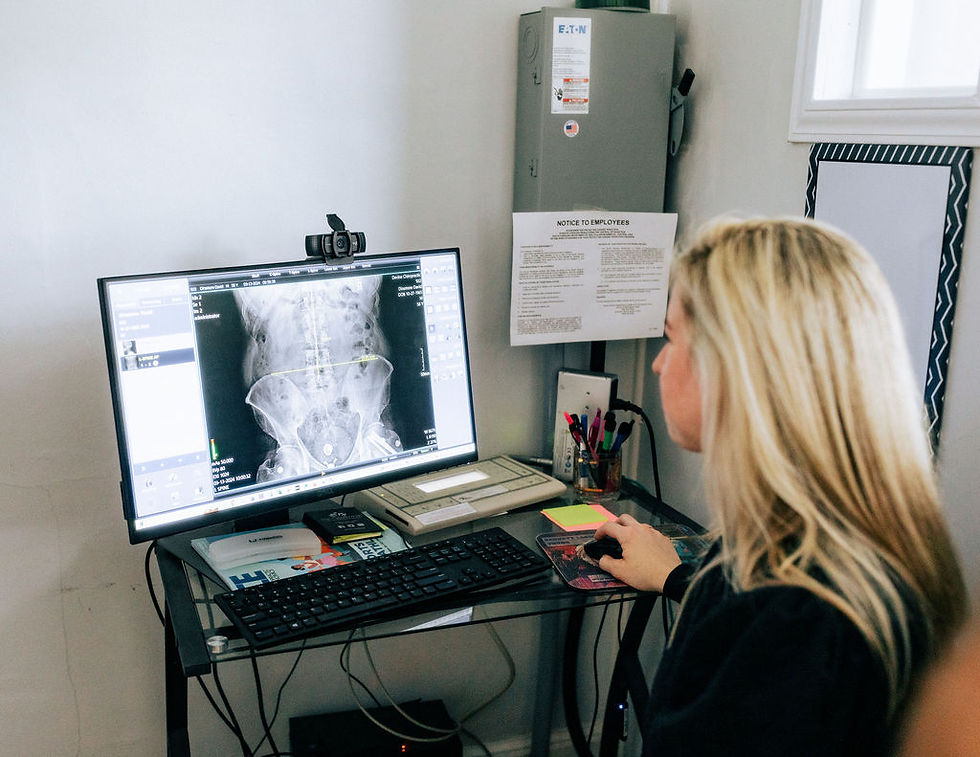What Really Happens During a Chiropractic Adjustment? Understanding the Process, Benefits, and Why It Feels So Good.
- Dr. Caroline

- Jul 29
- 2 min read
Have you ever wondered what happens during a chiropractic adjustment and why that snap of the spine often leads to instant relief and elevated wellbeing? A chiropractic adjustment is a precise, controlled force applied to spinal or joint misalignments that restores range of motion, releases natural pain‐modulating chemicals, and optimizes nervous system function. In this article, you’ll discover:
What occurs physically in your spine and joints during an adjustment
The science behind the pleasurable “feel-good” response
Immediate and long-term benefits for pain relief and overall health
What to expect at your first visit and how chiropractors assess your needs
Safety considerations, ideal treatment frequency, and common conditions treated
With a deeper understanding of each step, you’ll see how spinal alignment, joint cavitation, endorphin release, and neural signaling converge to promote lasting comfort.
What Happens Physically During a Chiropractic Adjustment?
A chiropractic adjustment applies a targeted thrust to vertebrae or peripheral joints, correcting subluxations, improving mobility, and reducing nerve irritation. This controlled force realigns joint surfaces, decreases tissue tension, and initiates a cascade of biomechanical and biochemical changes that prepare tissues for healing.
How Does a Chiropractor Identify Spinal Misalignments?
Chiropractors assess misalignments through a detailed combination of medical history, posture analysis, palpation, and range‐of‐motion tests. They evaluate vertebral position and mobility by feeling for asymmetry, muscle tenderness, and restricted joint play. Instrumented devices such as thermographic scanners or motion-analysis tools can supplement hands-on findings, ensuring precise localization of fixations that require adjustment.
By pinpointing restricted segments and muscular imbalances, the chiropractor determines which spinal levels need targeted thrusts to restore alignment and relieve nerve pressure.
What Techniques Are Used to Adjust the Spine and Joints?
Chiropractors employ a range of manual and instrument-assisted methods to restore joint motion and spinal alignment. Common techniques include:
Diversified Technique with high-velocity, low-amplitude thrusts to specific vertebral segments
Gonstead Adjustment using detailed X-ray analysis and precise contact points
Activator Method with a spring-loaded instrument delivering low-force impulses
Thompson Drop Table adjusting with segmented tab
le pieces that gently “drop” under the patient
Flexion-Distraction using rhythmic traction to mobilize spinal discs
Each method targets the joint capsule, surrounding ligaments, and mechanoreceptors to reestablish normal biomechanics and proprioceptive input for lasting relief.

Why Do You Hear a Cracking or Popping Sound During Adjustment?
The audible “pop” or “crack” during an adjustment, known as crepitus, results from rapid joint cavitation. When a controlled force separates the joint surfaces, dissolved gases (primarily nitrogen and carbon dioxide) in the synovial fluid form bubbles that collapse or burst. This gas release momentarily increases joint space, reduces local pressure, and creates an instant sense of release.
Understanding cavitation clarifies that the sound signifies mechanical decompression and improved joint lubrication, not bone-on-bone grinding.
How Does the Adjustment Improve Joint Mobility and Spinal Alignment?
By restoring joint kinematics and vertebral positioning, adjustments decrease abnormal stress on ligaments, discs, and muscles. Mechanoreceptors in the joint capsule receive new proprioceptive signals that retrain muscle tone and coordination. As the spine regains proper curvature and segmental motion, nerves exit the spinal canal without compression, enhancing neural transmission that governs organ and tissue function.
Improved biomechanics and reduced nerve irritation establish a foundation for pain reduction, increased flexibility, and balanced posture.




Comments